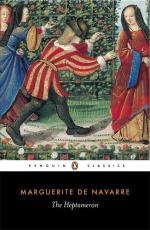Then, speaking of those images that had their arms lowered, the Proctor said that one should be for Master Gilles du Mesnil, father of the dead man, for he knew that as long as the father lived he would not cease to pursue him. Moreover, one of the women with their hands hanging down was to be for the Duchess of Alencon, sister to the King; for she bore so much love to her old servant, Du Mesnil, and had in so many other matters become acquainted with the Proctor’s wickedness, that except she died he could not live. The second woman that had her arms hanging down was his own wife, who was the cause of all his misfortune, and who he felt sure would never amend her evil life.
When his wife, who could see everything through the keyhole, heard him placing her among the dead, she resolved to send him among them first. On pretence of going to borrow some money, she went to an uncle she had, named Neaufle, who was Master of Requests to the Duke of Alencon, and informed him of what she had seen and heard. Neaufle, like the old and worthy servant that he was, went forthwith to the Chancellor of Alencon and told him the whole story.
As the Duke and Duchess of Alencon were not at Court that day, the Chancellor related this strange business to the Regent,(15) mother of the King and the Duchess, and she sent in all haste for the Provost of Paris,(16) who made such speed that he at once seized the Proctor and his sorcerer, Gallery. Without constraint or torture they freely confessed their guilt, and their case was made out and laid before the King.
15 Louise of Savoy.
16 John de la Barre,
a favourite of Francis I. See note to
Tale lxiii. (vol. v.),
in which he plays a conspicuous
part.—Ed.
Certain persons, wishing to save their lives, told him that they had only sought his good graces by their enchantments; but the King, holding his sister’s life as dear as his own, commanded that the same sentence should be passed on them as if they had made an attempt on his own person.
However, his sister, the Duchess of Alencon, entreated that the Proctor’s life might be spared, and the sentence of death be commuted to some heavy punishment. This request was granted her, and St. Aignan and Gallery were sent to the galleys of St. Blancart at Marseilles,(17) where they ended their days in close captivity, and had leisure to ponder on the grievousness of their crimes. The wicked wife, in the absence of her husband, continued in her sinful ways even more than before, and at last died in wretchedness.
17 This passage is explained by Henri Bouche, who states in his Histoire Chronologique de Provence (vol. ii. p. 554), that after Francis I.’s voyage in captivity to Spain it was judged expedient that France should have several galleys in the Mediterranean, and that “orders were accordingly given for thirteen to be built at Marseilles—four for the Baron




